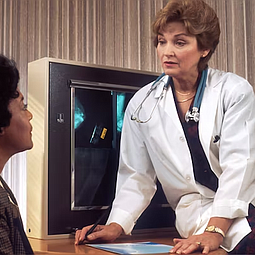AI May Help Improve Breast Cancer Outcomes
October 27, 2023 at 9:21 p.m.
Artificial Intelligence (AI) may soon be playing a much bigger role in diagnosing and treating various types of cancer. A new study has found that AI may be highly beneficial in the staging and treating of breast cancer. “Some cancers you can feel and see, but we can’t see microscopic cancer cells that may be present at the edge of the tissue removed. Other cancers are completely microscopic,” said senior author Dr. Kristalyn Gallagher, section chief of breast surgery in the Division of Surgical Oncology at UNC-Chapel Hill, North Carolina.
This new AI tool that has been developed provides a more accurate analysis of tumors removed surgically in real-time and increases the chance that all of the cancer cells are removed during the surgery. "This would prevent the need to bring patients back for a second or third surgery,” said Dr. Gallagher.
During surgery, a specimen is photographed using a mammography machine and reviewed by the team to make sure the area of abnormality has been removed. The specimen is then sent to pathology for further analysis. The pathologist can determine whether cancer cells extend to the specimen's outer edge or pathological margin.
If cancer cells are present on the edge of the tissue removed, there is a chance that additional cancer cells still remain in the breast. The surgeon might have to perform an additional procedure to remove additional tissue to ensure the cancer has been completely removed. However, this can take up to a week after surgery to complete. Now, that has changed and photographing the specimen with an X-ray can be done immediately in the operating room.
To "teach" their AI model what positive and negative margins look like, researchers used hundreds mammogram images and matched them with the final specimen reports from pathologists. To improve their model, the researchers also gathered demographic data from patients, such as age, race, tumor type, and tumor size. After calculating the model’s accuracy in predicting pathologic margins, researchers compared that data to the typical accuracy of human interpretation and discovered that the AI model performed as well as humans, if not better.
“It is interesting to think about how AI models can support doctor’s and surgeon’s decision-making in the operating room using computer vision,” said first study author Dr. Kevin Chen, general surgery resident in the Department of Surgery at UNC. “We found that the AI model matched or slightly surpassed humans in identifying positive margins.”
According to Dr. Gallagher, the model can be especially helpful in discerning margins in patients that have higher breast density. On mammograms, higher density breast tissue and tumors appear as a bright white color, making it difficult to discern where the cancer ends and the healthy breast tissue begins. Similar models could also be especially helpful for hospitals with fewer resources, which may not have the specialist surgeons, radiologists, or pathologists on hand to make a quick, informed decision in the operating room.
“It is like putting an extra layer of support in hospitals that maybe wouldn't have that expertise readily available,” said study co-senior author Shawn Gomez, who is a professor of biomedical engineering and pharmacology at UNC. “Instead of having to make a best guess, surgeons could have the support of a model trained on hundreds or thousands of images and get immediate feedback on their surgery to make a more informed decision.”
Researchers anticipate that the accuracy of their models will increase over time as they learn more about the appearance of normal tissue, tumors, and margins. Other tumor types may also soon be treated with similar AI technology.
 John Schieszer is an award-winning national journalist and radio and podcast broadcaster of The Medical Minute. He can be reached at medicalminutes@gmail.com.
John Schieszer is an award-winning national journalist and radio and podcast broadcaster of The Medical Minute. He can be reached at medicalminutes@gmail.com.





